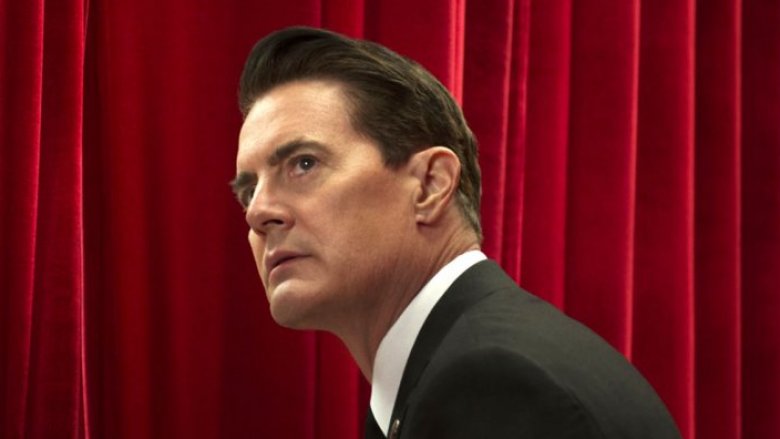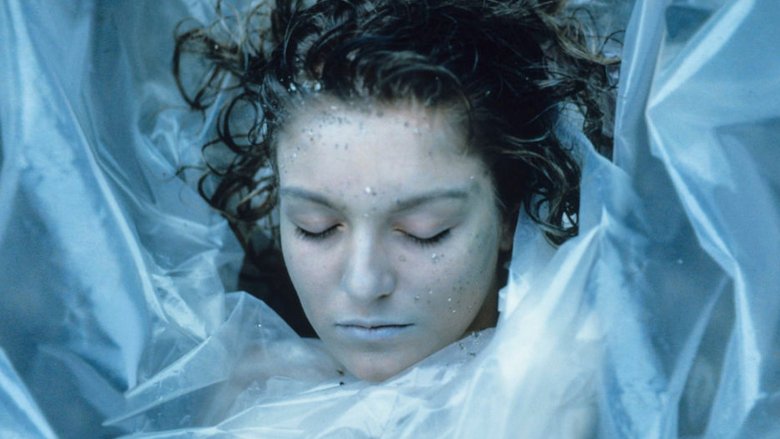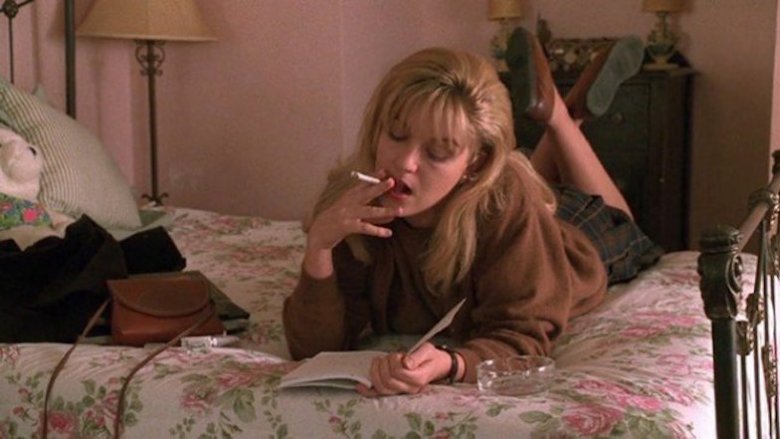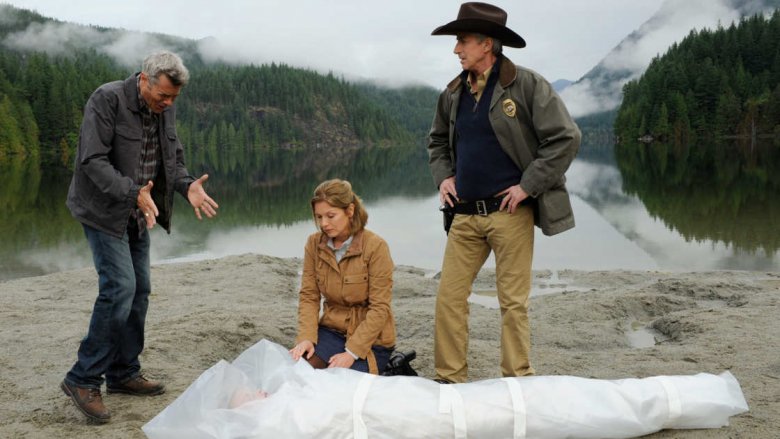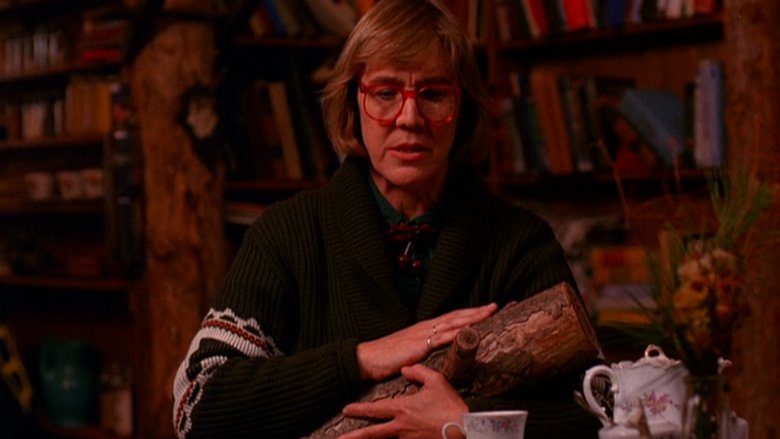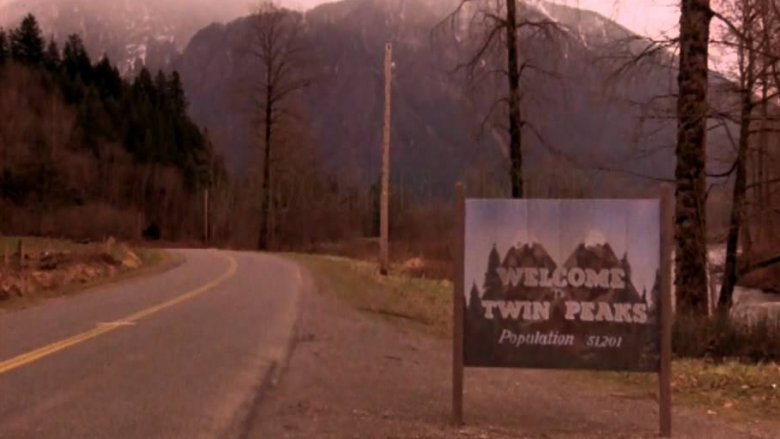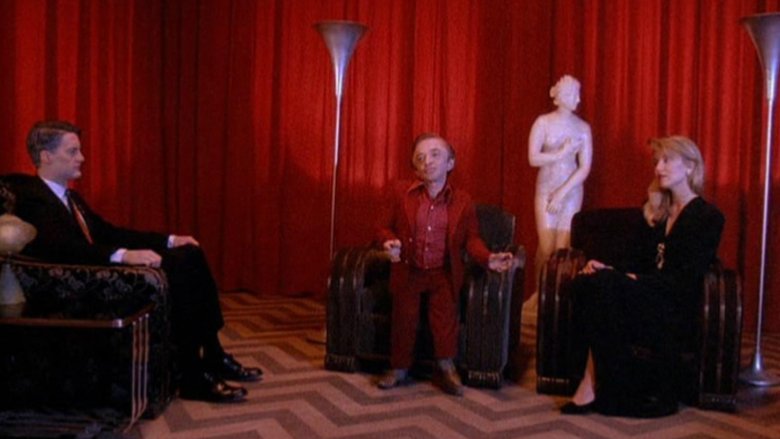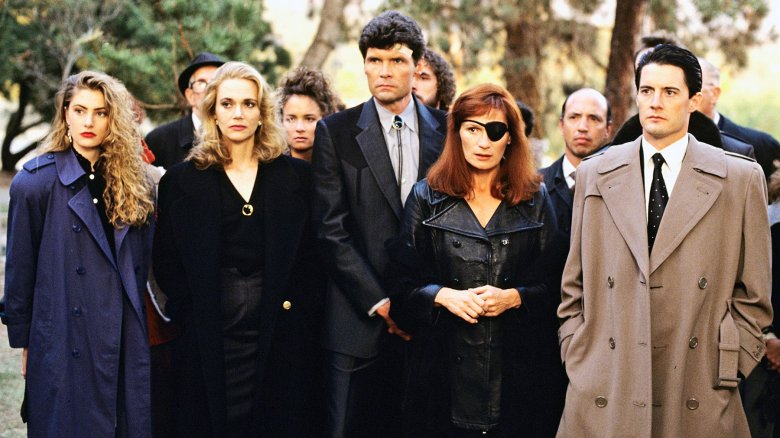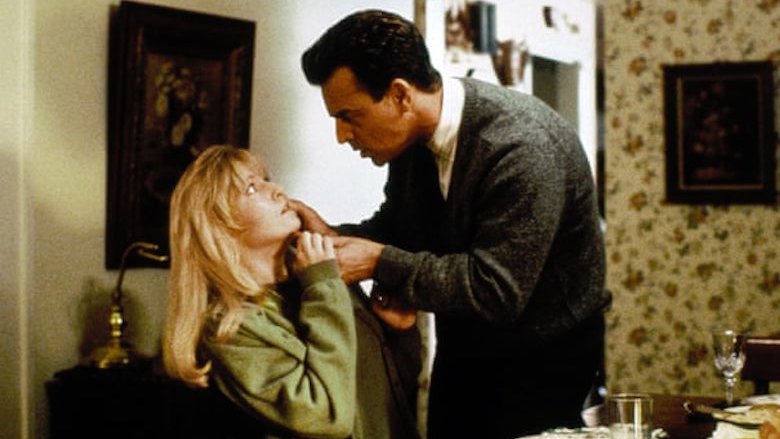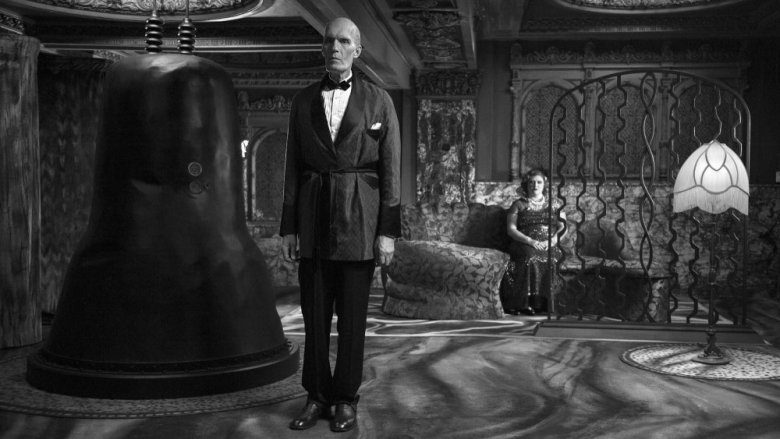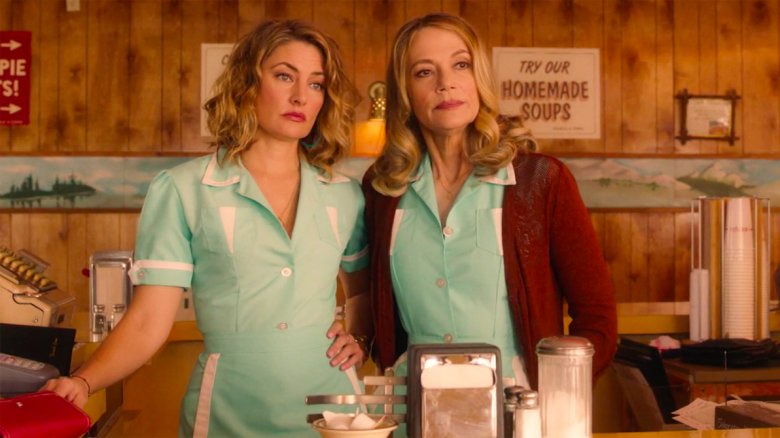How Twin Peaks Changed TV And No One Noticed
Created by cinema auteur David Lynch and Hill Street Blues writer Mark Frost, Twin Peaks followed Special Agent Dale Cooper (Kyle MacLachlan) into the titular town to investigate the murder of Laura Palmer (Sheryl Lee), the beautiful homecoming queen with many a dark secret to unravel. Featuring quirky characters, bizarre happenings, and an exposure of the rot underneath a picture-perfect American town, Twin Peaks brought a Blue Velvet vibe to the pastoral setting of the Pacific Northwest that equally enchanted and disturbed viewers. While David Lynch only directed six installments of the original two-season, 30-episode run, his surrealist style was the inspiration and framework for Twin Peaks' narrative structure.
Even David Lynch fans hadn't seen anything quite like Twin Peaks before, and though its reception at the time was mixed — especially after Laura's killer was revealed midway through season two — the style and substance of Twin Peaks changed television forever. That original run only lasted from April 8, 1990 to June 10, 1991, but its influences continue to reverberate in visual media. To understand how, we must return to those dark woods once again. As Agent Cooper says, "I have no idea where this will lead us, but I have a definite feeling it will be a place both wonderful and strange." Let's rock.
"Wrapped in plastic": Twin Peaks and its instant iconography
The first season of Twin Peaks was only eight episodes long — another rarity back in the day — but it was an immediate sensation with critics and audiences alike. These were the days before video on demand, so Twin Peaks fans quickly learned to get their VCRs armed with a blank tape to watch and rewatch each episode, both to search for clues and simply to escape into its unusual world. It's easy to see why — Twin Peaks is riddled with catch phrases and imagery that stick in your head almost like a song: "She's dead, wrapped in plastic." "A damn fine cup of coffee." "My log does not judge." "There's a fish in the percolator!" These phrases quickly became secret handshakes among Twin Peaks fans, tied to the dreamy image of Audrey Horne (Sherilyn Fenn) dancing and the taste of the best cherry pie around.
But by its second season, Twin Peaks began to falter. Lynch and Frost did not want to solve the mystery of Laura Palmer's murder, referring to the mystery as the "golden goose" that kept audiences hooked to the show. ABC executives were unconvinced, insisting they resolve this important plotline in the sophomore season. Before season 2 was halfway over, the story of BOB — the evil spirit that resided in Laura's father, Leland (Ray Wise) — had been revealed. Once this central mystery was tied up, viewers jumped ship and Twin Peaks' plot jumped the shark, spinning its wheels with aimless melodrama.
TV executives would eventually learn the value of leaving some questions unanswered (see Lost, a show directly influenced by Peaks), and of short, focused seasons (see any number of modern dramas untethered from the 22-episode model).
"The magician longs to see": From film to TV and back again
Twin Peaks limped to the end of its second season, with David Lynch finally returning to direct a surreal finale that ended on a horrifying cliffhanger. Dale Cooper was left trapped in the otherworldly Black Lodge, with his evil doppelganger on the loose. Intriguing as this dangling thread was, it was too late — the show was canceled.
Fans were annoyed to find that Lynch's next Twin Peaks project, Fire Walk With Me, would not be a follow-up to season 2, but rather a movie prequel exploring Laura Palmer's last days. Because of the movie's disinterest in answering the finale's questions (not to mention its darker, stranger tone), Fire Walk With Me was poorly received by audiences and critics alike upon its release in 1992. It would be years, decades for some, before Fire Walk With Me would be examined as a stunning work of art that empathetically explores the long-term effects of childhood abuse and sexual trauma on the life trajectory and choices of a young woman.
Though Lynch was not directly involved in most episodes of the series, Fire Walk With Me found him firmly at the helm, and he brought a new cinematic scope to the small-screen story. Today it's quite common for popular television shows that get cancelled to have a follow-up film in order to offer viewers some closure — take Sense8 or Veronica Mars. Lynch was one of the first to pull this off, even if its success was questionable at first.
"Doppelgangers": How pop-culture references kept Twin Peaks alive
Twin Peaks might have ended on a sour note for fans who wanted answers David Lynch never planned to provide, but pop culture would not let the phenomenon go. In the years since season 2, there have been hundreds of parodies, references, and homage to the show. From Saturday Night Live, The Simpsons, and Sesame Street to The Fresh Prince of Bel Air and Beverly Hills, 90210, the eccentric residents of Twin Peaks and the surreal atmosphere of the Red Room have loomed large over the TV landscape. Chevron floors, red curtains, and backwards speech remain cultural touchstones.
The crime comedy Psych even held a full-on Twin Peaks cast reunion in the fifth season episode "Dual Spires," a loving homage to the original series on its 20th anniversary. The episode is packed to the brim with references to the original show, not to mention enough anagrams and hidden secrets to make Agent Cooper proud.
Did the ambiguous endings help maintain Twin Peaks' hypnotic power in the collective creative consciousness? References to the show have yet to abate, which suggests yes, Twin Peaks is now a foundational part of American visual history.
"My log has a message for you": How Twin Peaks brought cinema to TV
In 1990, common wisdom was movies were highbrow and TV was lowbrow, with little crossover when it came to cast or creators. Cinema was art, and television was pop culture. Back then, it was unheard of that an Oscar-nominated surrealist filmmaker like David Lynch would ever do a television show. The prestige of movies like The Elephant Man and Blue Velvet was the kind of thing that shielded a creator from "needing" to work on network television. But in partnering with veteran TV writer Mark Frost, Lynch applied his unique atmospheric sensibilities to a serialized format, and ABC ate it up due to Lynch's reputation. They trusted the filmmaker to follow is instincts... at least at the beginning.
But Lynch wasn't the only trailblazer behind Twin Peaks. Frost's work on Hill Street Blues had prepared him to reel in viewers and keep them on the hook from week to week. His sense of intricate and dramatic TV plotting perfectly complimented Lynch's more esoteric tendencies, bringing an arthouse experience to a primetime audience.
Thanks in large part to Lynch, Frost, and Twin Peaks, prestige television shows are now the realm of inventive storytelling, with Oscar-caliber creators bringing their cinematic skills to the small screen. Ava DuVernay developed Queen Sugar, Meryl Streep is a regular on Big Little Lies, Spike Lee adapted She's Gotta Have It for Netflix, and the Wachowski Sisters brought their mind-bending talents to Sense8, among a growing list of others.
"A long way from the world": Situating crime in a suburban context
When Twin Peaks' first season aired, the content was shocking to many viewers. Up until that point, crime stories on screen — unflinching looks at murder, sexual assault, drug abuse, prostitution — were relegated to an urban context that often had racial and/or racist undertones. But Twin Peaks brought us to a quiet rural community in which the prom queen is a cocaine-addicted sex worker, the town's most respected businessman secretly owns an illicit brothel, and an intricate network of drug runners operates under the noses of a tiny police force. And that's just the beginning.
ABC producers had been concerned that the pastoral setting of Twin Peaks wouldn't be engaging for audiences, so much so that they reportedly had Lynch and Frost alter Twin Peaks' population from 5,120 to 51,201 in the opening credits. But because of the nature of crimes explored in Twin Peaks, this would end up being the least of ABC's concerns. It was shocking and fascinating to meet these residents of a town where everyone thinks they know everyone, and see them caught up in the kind of stories that usually happened on the meanest of mean streets.
Because of Twin Peaks, the small town with big city crime would become a frequent setting for crime shows and television dramas. There would be no Top of the Lake, The Killing, Fargo, or even supernatural fare like True Blood and Buffy the Vampire Slayer without Twin Peaks' legacy.
"A fish in the percolator": David Lynch's singular surrealism
Up until Twin Peaks, episodic television tended to work from a template. Each episode had a reliable structure, and often previous arcs wouldn't necessarily be mentioned again, allowing viewers to pick up anywhere in a story. Twin Peaks smashed that traditional mold, focusing on the bigger pictures of the secrets abounding in Twin Peaks while handing out small clues that slowly came together over the course of the series. We would see more and more of this kind of storytelling as years went by, in shows like Veronica Mars, Lost, and True Detective, with narratives paced deliberately, unusually structured, and sometimes revealed out of chronological order.
In this way, audiences were introduced to David Lynch's singular form of surrealism, including the distinctly Lynchian feature of focusing the camera for long takes on scenery or inanimate objects as action and dialogue takes place around them. This trick often forces viewers to ascribe added meaning to what we're seeing as we wonder how all the pieces fit together.
As writer David Foster Wallace once said, "What Lynchian means is something about the unbelievably grotesque existing in a kind of union with the unbelievably banal." In this vein, the magical realism in Twin Peaks was performed so practically that it opened the door for a seamless melding of realistic situations and crimes with a mystical element. The pastoral setting combined with supernatural elements and dream logic would years later inform The X-Files, which also offered a number of homages both covert and obvious to Twin Peaks during its long run.
"Is it future, or is it past?": Prestige television inspired and influenced by Twin Peaks
Despite the initial disappointment in Twin Peaks' second season and Fire Walk With Me, the show's cult following grew exponentially as Twin Peaks came to DVD and streaming services, revealing its mysteries to a new generation. Being able to watch the episodes over and over, its stunning cinematography remastered in high definition, allowed new and old fans to engage with Twin Peaks in fresh ways. This also lead to many new television productions being openly inspired by the events of Twin Peaks, such as The Sopranos, Top of the Lake, and True Detective.
The creator-driven framework solidified in the first season by Lynch and Frost soon became ubiquitous in the television industry. J.J. Abrams' Lost became a phenomenon in its own right and like Lynch/Frost, led to Abrams becoming as much a household name as the stars on his show. The Sopranos creator David Chase had a similar experience, along with True Detective's Nic Pizzolatto. The kind of singular vision that had once made ABC nervous enough to meddle in Twin Peaks' second season is now seen as a strength.
"Fire walk with me": Twin Peaks' compassion for victims and survivors
As Twin Peaks peeled back the layers of Laura Palmer's secret and not-so-secret lives, audiences were horrified to discover that the root of her trauma was ongoing sexual abuse at the hands of her father since she was a little girl. The show ultimately reveals that an evil spirit had possessed Leland Palmer to do this to his daughter, fitting with the more supernatural aspects of the show's strange world. This changed the game in bringing the taboo subjects of rape and incest into the spotlight.
Of course, the series couldn't spend all that much time dwelling on the details of Laura's horror. But when Lynch began work on Fire Walk With Me — fully in control and freed from the content restrictions of TV, he brought the reality of sexual abuse into a clearer focus. The spiritual elements remain, but only to support a compassionate presentation of Laura's final days.
Lynch's focus on Laura's humanity, as well as Sheryl Lee's masterful and empathetic portrayal of a young girl on the verge, continues to resonate with survivors, many of whom reach out to Lee at fan conventions. Without Twin Peaks first opening this door on television, we would not have Law and Order: SVU, Veronica Mars, 13 Reasons Why, and even plot threads around sexual assault in shows like Sons of Anarchy and Dexter.
"It is happening again": Twin Peaks' third season revolutionized television once more
The 2010s have seen TV nostalgia bloom in fields of remakes, reboots, and revivals like 90210, Dynasty, and McGuyver. It was no surprise, then, that Peakies began hoping for a return to their weird and beloved town. After years of rumors and teasing, as well as a complex development process, Lynch and Frost announced in 2014 that yes, indeed, we would be journeying back to the Pacific Northwest with a new set of episodes continuing the story. Twin Peaks: The Return finally debuted on Showtime in 2017, almost 25 years to the day since Laura delivered her famous message to Cooper in the Red Room: "I'll see you again in 25 years."
This time, there would be no outside meddling from network executives or scattered co-writers. All 18 episodes were directed by Lynch from a huge script penned by Lynch and Frost in a process approached like one extremely long movie. Featuring the surprise returns of many characters in new forms and iterations, The Return was a unique experience with a singular vision. The third season simultaneously fit into the TV landscape the original seasons had helped pioneer, while revolutionizing the format all over again.
"I'll see you again in 25 years": Women allowed to age on screen
While The Return brought various new Lynchian narrative tricks into the mix, it also set a precedent in allowing its women characters to age on screen. Unlike shows such as the 90210 reboot, which focus on a fresh group of youngsters with original cast members appearing as cameos, The Return made sure we revisited the original players 25 years later. The older women of Twin Peaks are just as messy as they once were, but have all moved forward in their lives in different ways.
Nadine Hurley (Wendy Robie) finally has developed her silent drape runners and is now a thriving shop owner. Norma Jennings (Peggy Lipton) is doing so well with her RR Diner that the business has become a franchise. Shelly (Madchen Amick) may still be a waitress at the RR with terrible taste in men, but she radiates happiness in a way she never did in the show's original run. In contrast, the young characters introduced by Lynch in The Return are a dirty, infected, drug-addicted, and generally misbegotten bunch who speak to the decline of Twin Peaks in the past 25 years.
In the wake of The Return, we have seen shows and reboots — like Murphy Brown and The Conners — that focus on beloved actors and characters from back in the day as central figures, rather than peripheral older folks. Twin Peaks: The Return shifted television's youth-oriented paradigm into something more inclusive that offers older actors — particularly older women, who historically aren't represented on TV — a chance to be seen center stage.
